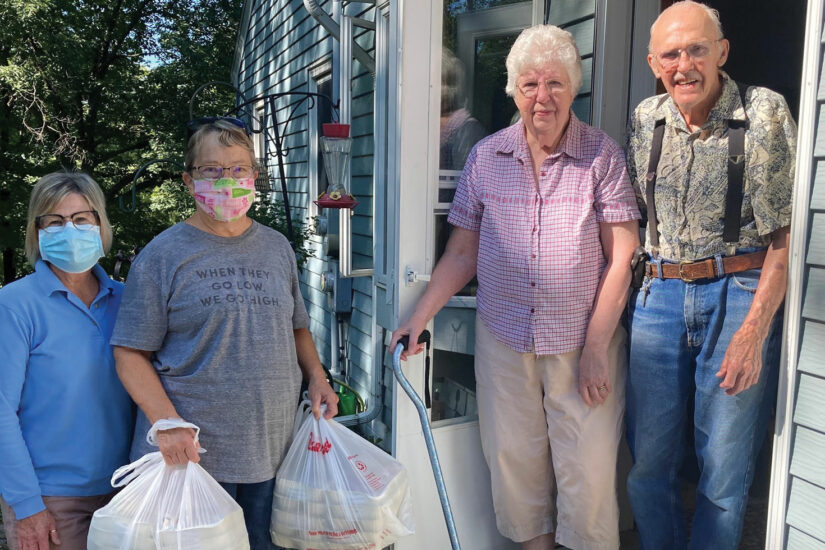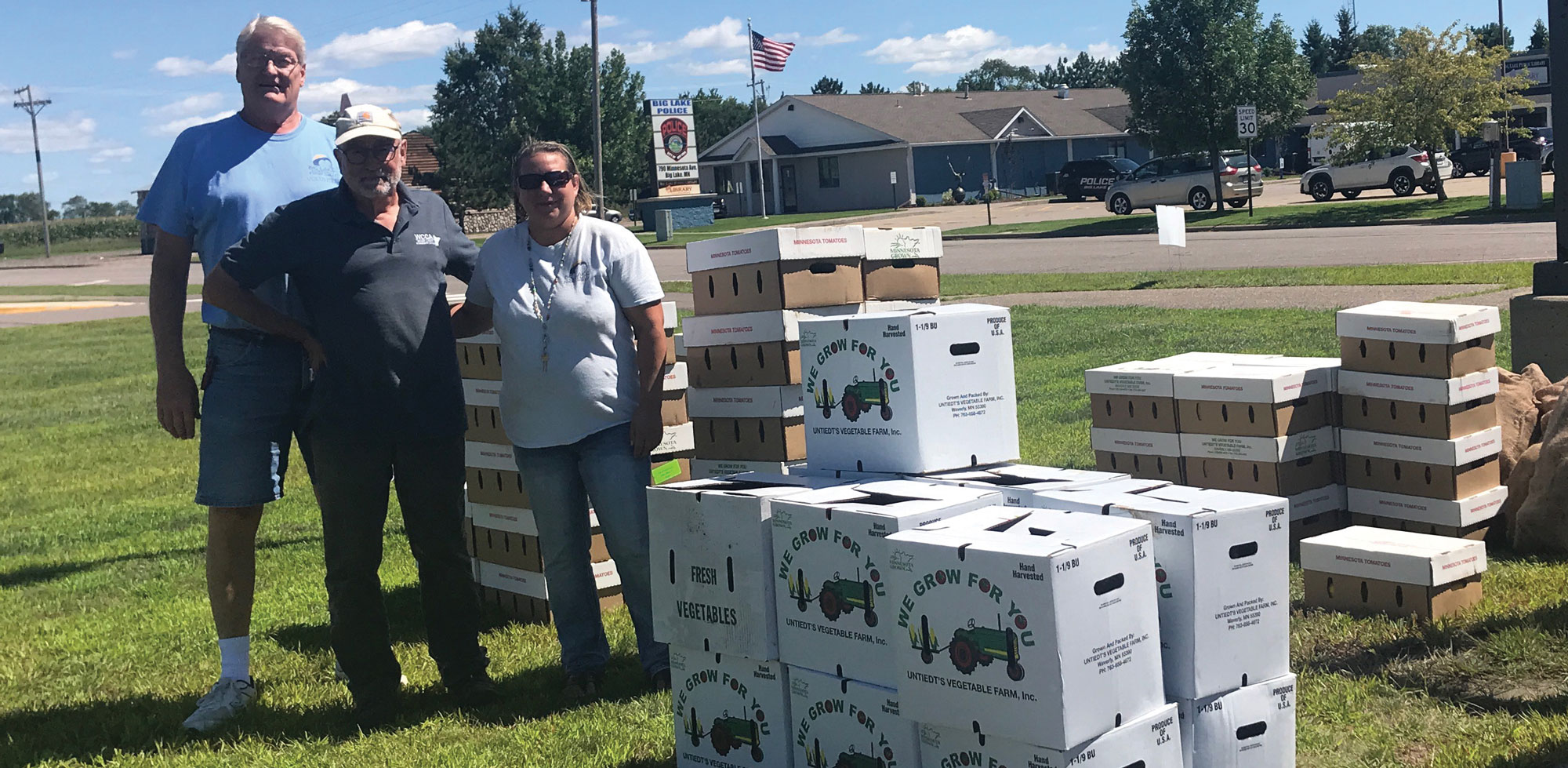
Food for Our Friends
People across Central Minnesota are experiencing food insecurity due to the COVID-19 pandemic. Here’s what local organizations are doing to meet the need.
By Stephanie Dickrell | Photos courtesy of Wright County Community Action, Maple Lake
A contagious and deadly virus has made its way to your city. Schools go online. Other public places, including restaurants, close in a statewide effort to slow infection rates.
You have been placed on furlough and your spouse is working remotely. This means both of you are at home, 24/7. And so are your kids, who normally get their breakfast and lunch at school. You are out of flour and eggs but those items are in short supply, which is almost beside the point because you are having a hard time paying your food bills.
This is the situation facing hundreds of thousands of Minnesotans as the COVID-19 pandemic takes root across the state, where an additional 275,000 people—112,000 of them children—report challenges affording food, according to Second Harvest Heartland, a food bank and hunger relief organization that serves Minnesota and Western Wisconsin. Before the onset of the pandemic, one in 11 Minnesotans experienced hunger. Today, that number is one in eight.
Of all social needs that have been laid bare by the coronavirus, none is as glaring as the importance of healthy and reliable food sources. In response to the sudden food shortage, individuals, businesses, service organizations and nonprofits—including the Initiative Foundation—have mobilized to get food to people at a time when food banks and food shelves are facing up to a 65 percent increase in demand.
“It is crucial to get emergency funding to the people and organizations that are on the front lines of food production and distribution so that they can feed those in need,” said Don Hickman, vice president for community and workforce development at the Initiative Foundation. To help in that effort, the Foundation quickly changed the way it distributes grants and funding. Traditionally, Initiative Foundation grants of up to $2 million annually have focused on innovative programming, strategic planning and other capacity-building projects for nonprofits, schools and local units of government. When the pandemic hit, the Foundation adjusted its priorities to focus on direct services, including food distribution and, thanks to local generosity and a host of funding sources from outside the region dramatically increased its grants distributions.
In Sherburne County, Community Aid of Elk River (CAER) drew on its local expertise to quickly adapt existing services, including a food shelf, to help children and seniors. With a $10,000 grant from the Initiative Foundation, CAER pushed up the start date of Kidz Kitz, its annual summer food program, to align with the closing of schools in March. The shift in Kidz Kitz distributions added 11 weeks of food for families. The program distributed nearly 2,700 Kidz Kitz, totaling more than 65,700 pounds of food, according to Heather Kliewer, CAER’s executive director.

The kits include breakfast and lunch items for two kids, every week. Each is designed to meet nutritional standards, including fresh fruit and vegetables when possible, grains, protein and dairy. “The kids are so excited to look through the box,” said Kliewer. “They want to know ‘What did we get this week?’”
In Wright County, Wright County Community Action (WCCA) received a $5,000 grant from the Initiative Foundation to expand its frozen meal program to quickly get food to senior citizens who were previously independent and able to shop for and prepare their own meals. Since March, more than 1,350 new seniors have applied for services. The program delivered more than 48,000 frozen meals in that time.
WCCA staff also discovered many of these people could remain independent by learning how to shop online for delivery or contactless pickups. “It helped to have a bridge to help seniors get self-sufficient,” said Jay Weatherford, WCCA’s executive director.
EXPANDED SERVICES
Those early food-related successes lead to other services. In Wright County, staff and volunteers also increased their health and reassurance calls to seniors. They check in, ask about health, food, money, home and safety—and sometimes just listen. Since March, they’ve made more than 1,500 calls each month, averaging more than seven minutes per call. WCCA callers log information so the organization can track seniors’ needs and spot trends over time.
“With seniors… one week, everything is going great [and] the next week, it’s panic because of a health or money problem,” said Weatherford. “They’re frightened about getting the virus.”
To respond to these concerns, both CAER and WCCA adjusted their food shelf programs, implementing curbside pickups and order forms. They also worked with other nonprofits to do large produce drops to reach as many people as possible. CAER distributed 20,000 pounds of food in emergency boxes of produce to 335 households in May alone, with help from Second Harvest Heartland. The number of new households served doubled to 470 this year, from 235 in 2019. And families don’t have to show bank statements or unemployment checks to prove they’re in need.
COMMUNITY PARTNERS
Businesses, community members and nonprofits across Central Minnesota also have stepped up, offering everything from kitchen and freezer space to donations of fresh produce. The Sherburne County Fairgrounds, for example, became a place for nonprofits to distribute food and services. School districts notified families about CAER’s services and also allowed the nonprofit to distribute food in school parking lots.
“It made it feel a little more normal,” Kliewer said. In fact, lessening the stigma of getting help became a priority. For example, food shelf deliveries are designed to look the same as grocery delivery services.
WCCA also has benefited from numerous community partners, including the Waverly Cafe in Waverly, which paid its staff to produce senior meals, offered catering expertise and the use of their commercial kitchens.
Another local business, Untiedt’s Vegetable Farm, donated vegetables for senior meals and other people needing food. In August, the farm donated more than 1,100 bushels of fruit and vegetables—anything from cucumbers to cauliflower to cantaloupe. It also delivered more than 650 boxes of fresh farm produce in August to other distributors working to alleviate hunger.
The nonprofits also learned new ways to do business. WCCA distributed more than 35,000 meals since early April, via volunteers riding on Trailblazer Transit public buses.
SILVER LININGS
While the pandemic has put stress on these nonprofits, it has also brought new insights that will help them going forward. Today, more seniors in Wright County now know about WCCA and how it can help. “When this first took off, you wouldn’t believe the ride,” said Weatherford. “We had 60 or 80 applications coming in a day.”
Weatherford said people can call WCCA about any challenges they are facing. If WCCA can’t help, they’ll find someone who can. In addition, the need to understand technology and how to use smartphones will only increase for the region’s seniors.
The vital role that volunteers play was only underscored by the pandemic. “The patience of everybody, families and donors alike, staff and volunteers … they all know this is something we have no control over,” Kliewer said. “The response, the generosity — it didn’t surprise me. Our community is there.”
Finding What Works
The goal is to better serve people by going directly to the people in need.
When Greater Minneapolis Community Connections (GMCC) received an anonymous $500,000 gift to help rural food shelves in Minnesota, the nonprofit approached the Initiative Foundation for help distributing
the funds.
“We wanted to work with partners in the region on how to support local farmers and connect them to markets, and how to connect the food shelves to the supplies that they need,” said Adrienne Dorn, GMCC’s executive director.
GMCC found a ready partner in Sprout, a marketplace, food hub and kitchen in Little Falls. The nonprofit aims to connect and strengthen the local food system as a regional asset by giving people easier access to healthy foods through cooking classes, community-supported agriculture programs and nutrition education. Sprout also has experience working with people who are food insecure, including low-income veterans, people who are in recovery from addiction and people living with mental illness.
GMCC contracted with local people to go into their communities and talk to friends, family, coworkers and neighbors about the challenges and gaps they faced accessing food. Staff from Sprout and GMCC also did in-depth interviews with food shelves and other organizations. They then identified common barriers and potential next steps. For example, a single mom with two children crying in the next room probably won’t spend two hours preparing fresh, local food. The solutions needed to be useful to the people using them.
“The goal is to better serve people by going directly to the people in need,” said Zach Tabatt, nonprofit development program officer at the Initiative Foundation.
The groups found that a relationship between a local farmer and food shelf volunteer can make a difference. So can asking a local service club to deliver food or improve food shelf locations.
Still, barriers to food access remain, including transportation. With little to no public options, people in Central Minnesota have to rely on cars—which are costly and come with ongoing expenses—or the generosity of others.
Where available, Tabatt said, using rideshare companies such as Uber and Lyft to deliver food is one possible solution. Other options include transportation services for low-income people by groups like Tri-CAP, which operates in Benton, Sherburne, and Stearns counties.